Whether your house is overflowing with travel car seats (as mine is), you keep one cheap backup car seat for grandma to borrow or you want to hang on to your infant car seat for the next baby it’s important to think through your car seat storage options. In this article we’ll cover a few important topics:
- Car seat storage pitfalls
- Preparing your car seat for storage
- Where to store a car seat
- How to store your unused car seat long-term
You’ll also get to see plenty of nooks and crannies of my house that are now occupied by spare car seats in storage!
What can go wrong when you’re storing a car seat
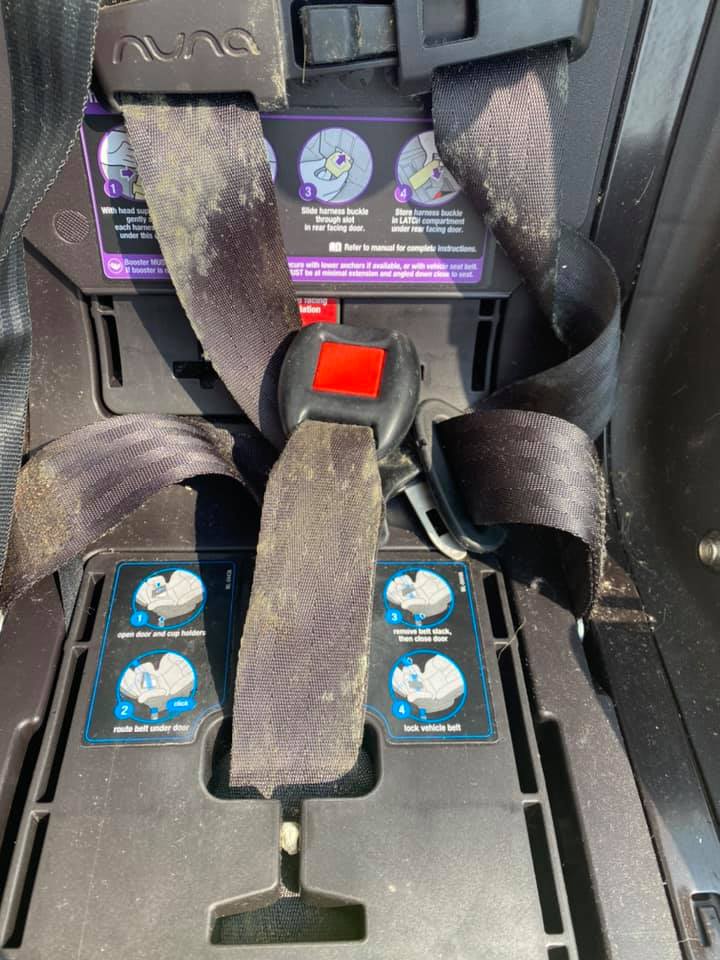
There are a few reasons why you shouldn’t just toss your car seat in the garage or even a closet without a second thought. Potential risks include:
- Mold
- Rodent or insect issues
- Filth
- Missing parts
- Expiration
See that $700 car seat above? It was stored in an interior closet with a few other car seats. Now it’s in a dumpster, along with its two other moldy comrades.
Of course there are plenty of other challenges, but these are the main ones. With the strategies I’ll present below, you’ll maximize your chances of being able to use your spare car seat for many years to come!
Preparing your car seat for storage
Before you store your car seat, you want to be sure it is clean, dry and complete. Even if you’re just putting it in the corner of your child’s bedroom for a few weeks between trips, this is still good practice!
Check the expiration date
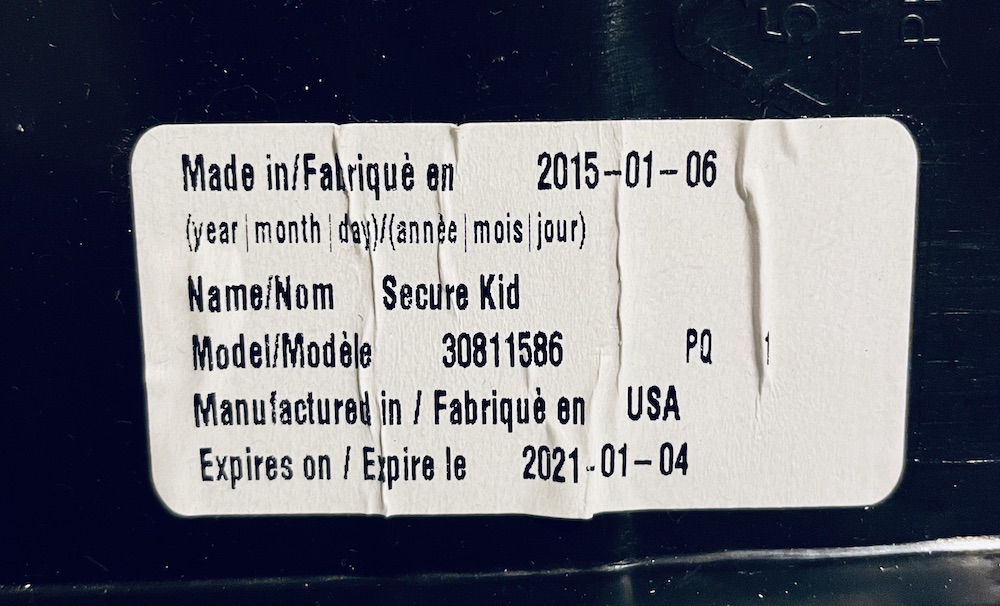
Before you get started, unless it’s a pretty new seat you should check the expiration date. Sometimes there’s a sticker on the back while for some seats it’s embossed in the plastic on the back. Above is an easy-to-decipher sticker that tells us that dates of manufacture and expiration. If yours just lists manufacture date, check your manual to find out how long you can use it.
(Yes, I know this seat is expired. I keep it for training use and product modeling, but eventually it’ll be traded in.)
Be honest in your evaluation: will you use the seat again before it expires? That’s an especially important question for an infant car seat, which often has a shorter usable life. A family member recently had her third child, 5.5 years after the first. Their infant car seat had been purchased as a shower gift a few months after it was manufactured (typical timing) and she was disappointed to realize that it expired right when the new baby was born.
The same goes if you have something like a combination car seat that an older child has outgrown but a younger child isn’t close to using. It can be disappointing, but in a situation like that it’s better not to bother storing. The wonderful seat whose sticker is pictured above sadly only had a usable life of 6 years.
If your seat is expired or will expire before your family needs it again, you can consider taking it to the Target car seat trade in to be recycled. You’ll get 20% off a new car seat, on top of many great sale prices! These events are typically held in spring and fall and they’ll take anything from high-end convertible car seats to infant car seat bases and backless boosters. Condition and expiration don’t matter.
Cleaning your car seat for storage
At a minimum, you’ll want to take your car seat outside and shake out any crumbs and run a vacuum under the cover inside the shell. You may want to have a damp rag (just water) handy to wipe off any congealed food. Why? Because mice like the smell of old french fries too! Unfortunately you can’t power wash a car seat.
If your child eats or drinks a lot in the car, you may want to consider disassembling your car seat (if the manufacturer permits it) to wash the cover. Many car seats today permit washing on delicate with additive-free detergent; a few even allow machine drying, though that’s less common. Be sure to refer to manufacturer instructions.
You can’t put harness straps in the washing machine or even saturate them in the sink. Getting them fully wet softens the fibers and may permit them to stretch more than expected in a crash, putting your child at risk of injury. You can wipe them with a damp cloth or a baby wipe, but that’s generally it. If you’re thinking about using anything more be sure to reach out to your car seat manufacturer to ask if it’s ok.
Pop out the cup holders to wash them if that’s an option. Many are dishwasher safe, but even the ones that aren’t will do well with hot soapy water in the sink… and maybe a scrub brush.
Be sure your car seat is dry
Don’t skip this step, because it’s probably the most important one. You must make sure that everything is absolutely dry before storing your car seat. If your car seat cover can’t be dried in the machine, hang dry for several days until it’s bone dry. The last thing you want is the dreaded mold on a car seat, because in nearly all cases that’ll send your car seat to the scrap heap.
Drying the cover outside is also a great choice (as long as it’s not too humid). In addition to drying, the sun is also a fantastic disinfectant. Its UV radiation kills all sorts of germs and is awesome for removing stains and odors.
Store all parts together
If you’ve disassembled your car seat to clean it, be sure to put it back together properly once it’s totally dry. Be sure you have any infant inserts for a bucket seat or convertible car seat. If you have a car seat that’s been converted to booster mode, be sure that the harness and crotch buckle are either attached or stored with the seat. The same goes for required cup holders.
Make sure to keep the manual with the car seat too. If you’ve lost it, nearly all manufacturers will send you a new copy for free. Order it now while you’re thinking about it, not months or years down the line when you’re scrambling to put the seat back into service and can’t remember how to set it up for a younger child.
Where to store a car seat
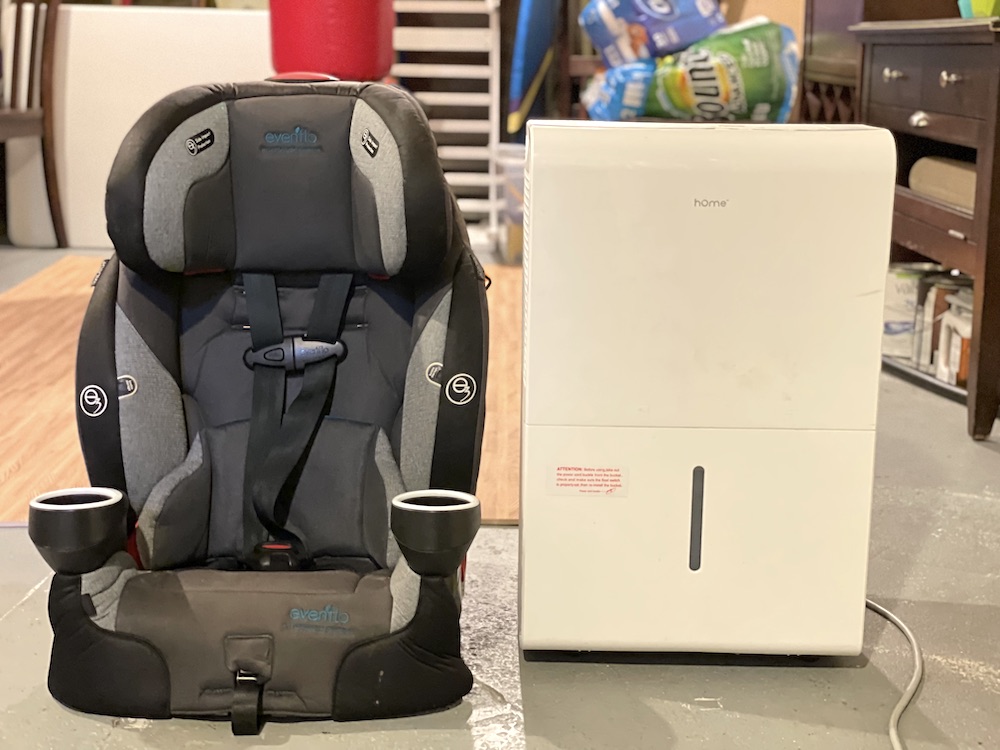
Many car seats are space hogs, so it can be tough to find the right place to store them. If car seat manufacturers got to pick where you stored your seats, undoubtedly they’d like you to put them in the middle of a climate-controlled room in your house with great air circulation. Why? Because you’d minimize your risks of mold, filth and critters.
While I may store car seats all over my house (as of this writing they’re in five different rooms) you probably don’t want to do that. If you can spare the space, a spare room or dry closet in your house it one of the better options. We currently have one up on a high shelf where it’s out of sight, out of mind and far from any bathrooms. I also have some folding car seats sitting in my office, but that’s not for everyone.
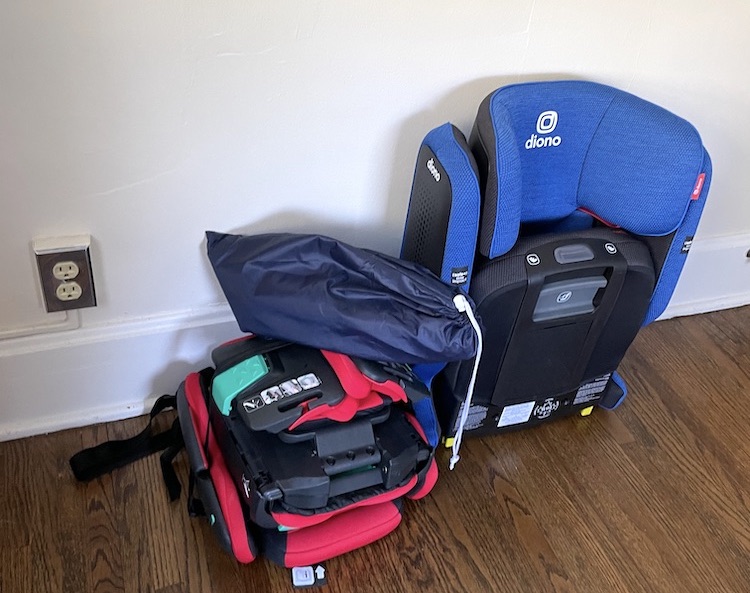
Your basement can be a good option provided it’s not too damp. Since we live in the Midwest, we run one of these for most of the year and it keeps things quite dry. We have a car seat that’s been stored in that same room (pictured above, in my cluttered basement) for over a year and there’s no sign of mold or any other issue since it’s dry and there’s plenty of air circulation.
Garages are another popular car seat storage option but, depending on where you live and the details of your garage, they can be among the most problematic. In many places garages get hot and humid in the summer, which can give rise to mold on your car seat. In other places you may find that a mouse deemed your car seat a good source of Cheerio crumbs and chewed on the harness straps or car seat cover in the process. Some manufacturers offer replacement for those items, but not all.
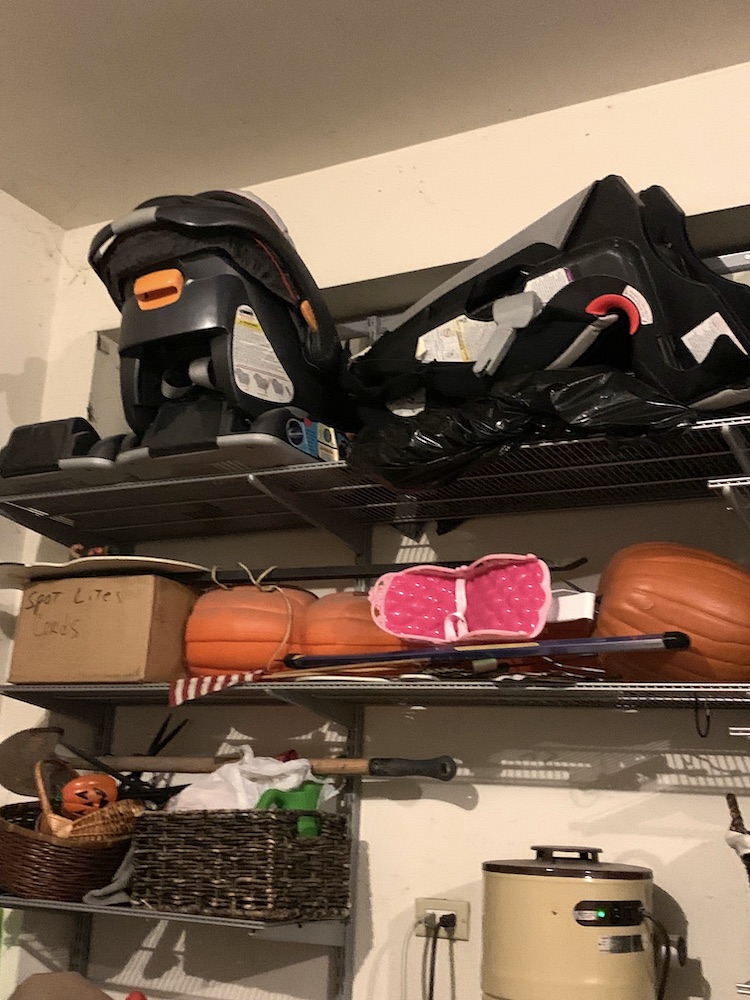
If your garage is nicely finished and insulated and you treat it as another room of the house, it may be just fine for storing your car seat as long as you keep an eye on it. You might consider storing it on a high shelf – something like a wire mesh floating shelf will allow at least a little air circulation and is harder for critters to access. The photo above is my sister-in-law’s garage, and I’ve verified that the seats up there are totally fine (if a little dusty) even though they’ve been up there for almost two years.
The same precautions would apply when using a storage unit. If it’s a climate-controlled facility, still try to keep the car seat fairly high and in a place where there’s air circulation.
Because I’m a CPST and I have a million extra car seats, I do keep spare booster seats in my trunk frequently for two reasons. First, if I don’t have them in my car they take over my house! Seriously. Second, with kids who are carpool age it’s nice to be able to instantly convert my smallish car into a 3-across set up and that requires some of the narrower booster seats that we don’t use often.
There is a risk to storing car seats in your trunk. If I were to be involved in a crash I would potentially need to replace the spare seats as well. It would depend on the severity of the crash and the stance of each manufacturer. If you don’t have an extensive collection of spares, take this path at your own risk!
How to store your unused car seat long-term
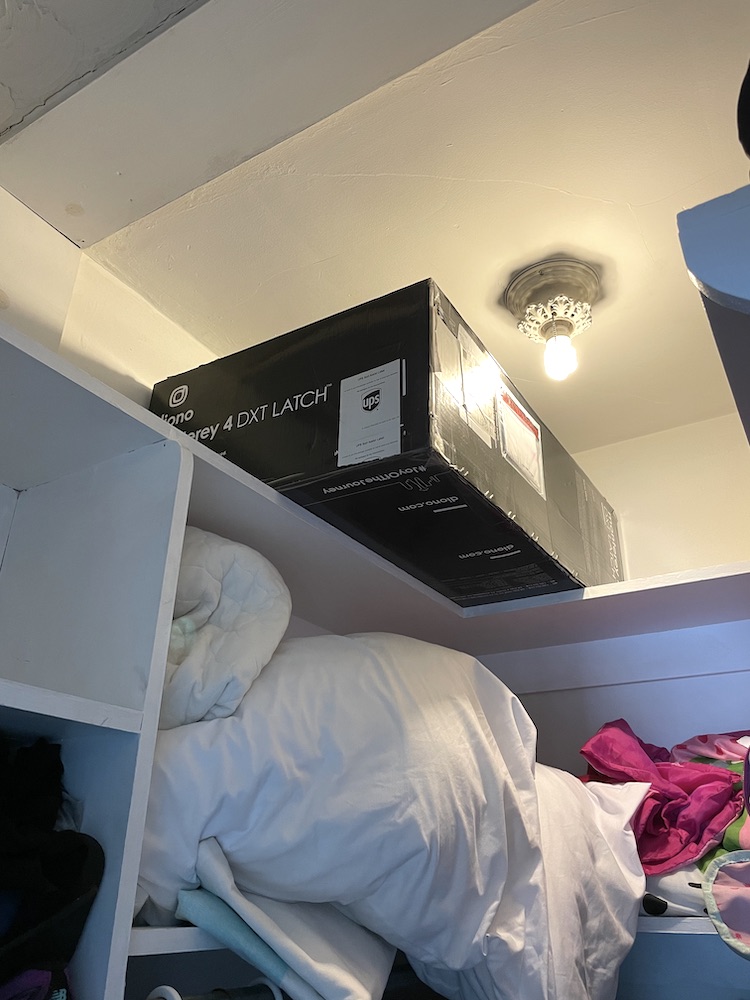
Whew, now that we’ve gotten through the preliminaries it’s finally time to put that car seat into storage! There are a few more tricks you can use to maximize the chances of using it in the future.
If it’s a brand new seat like the one above and you have no need to use it for a while, leave it all packed up! This seat is bagged, boxed, sealed and has a moisture-absorbing packet inside. It’s in a dry-but-frequently-open closet and hasn’t been exposed to any moisture since arriving at our home (and no juice was ever spilled in it, obviously). I feel confident shoving that box on the shelf and not giving it much thought.
If you’re storing a car seat in a place where you’re concerned about critters or water intrusion, you might want to put it in a huge storage bin. That’s easier said than done with some of today’s jumbo-sized car seats. This storage tote should fit most infant and combination car seats and all booster seats.
For a bulkier seat like a huge convertible or all-in-one, you may need to upgrade to one of these with a lid. I wish I were joking about the size you might need for some of the biggest car seats out there, but they’re just huge. If the seat only has a year or two before expiration, it might be worth leaving it in a cardboard box or even without any sort of storage container and just accepting the risk. It might be just fine!
Even a cardboard shipping box will provide some protection against filth and critters. Once your car seat is thoroughly clean and dry, you could put it in a heavy-duty garbage bag, tie it up and box it.
But now for the best cheap trick: get yourself some silica gel to prevent mold! Those little packets they put in all sorts of items are great for absorbing excess moisture and can really make a difference. These high-capacity packets are extremely effective and you can even reuse them by drying them out in the microwave! If you’re storing your car seat in a box or bin, just place a few packets in there and you’re ready to go. Check them once every month or so to see if you need to recharge.
If you’re storing your car seat in a closet with poor circulation or near a source of humidity, you can instead hang one of these bags and change it out every month or two. Everything in the closet will stay mold-free and avoid musty smells! For a larger space like a basement or garage, you can place one of these buckets near the car seat.
I hope this article has given you the tips you need to safely store a car seat and keep it nice enough for future use. As always, be sure to ask any questions in the comments below!

Hello Melissa,
What an insightful guide on car seat storage! 🚗✨ I never realized how proper storage could extend a car seat’s lifespan. Your tips are invaluable for parents on the go. Kudos for promoting safety and convenience!
Thank you!